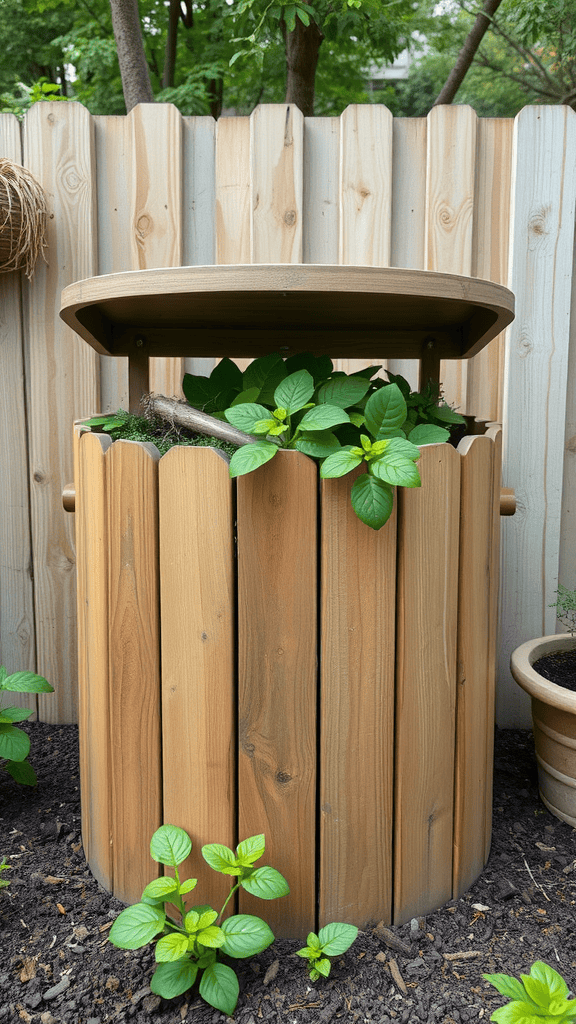Understanding Natural Compost Bins: Benefits and Features
Composting is an eco-friendly way to recycle organic waste while enriching your garden soil. A natural compost bin is one of the best tools to make this process efficient and effective. But what exactly is a natural compost bin, and how can you use it?
A natural compost bin is usually made from organic materials, designed to blend harmoniously with nature. Unlike traditional compost bins made from plastic or metal, these bins often use materials such as wood, straw, and sometimes even sturdy wire to form a more balanced composting environment. This type of compost bin allows for better aeration, which is crucial for the composting process. With proper air circulation, microorganisms can thrive, breaking down organic matter quicker.
Benefits of Using a Natural Compost Bin
- Eco-Friendly: By using natural materials, you contribute to sustainability and reduce plastic waste.
- Enhanced Aeration: Natural compost bins provide better airflow, speeding up the decomposition process.
- Natural Insulation: The organic materials can help regulate temperature, promoting healthy bacteria.
- Customizable: You can create your compost bin in a size and shape that fits your space and needs.
- Cost-Effective: Often, you can source materials for your compost bin locally or repurpose items you already have.
When using a natural compost bin, it’s important to understand its features to maximize effectiveness. The performance of a compost bin depends on several factors, including its design and the materials used. Below are some essential features to consider:
- Size: The size of your compost bin should match your composting needs. A larger bin can handle more waste and may be ideal for families, while a smaller bin can fit well in a compact garden.
- Material: Opt for rot-resistant wood or durable natural fibers if you choose a wooden design. You could also use chicken wire for added air flow when dealing with larger piles.
- Location: Place your compost bin in a well-drained, sunny spot to facilitate the natural breakdown of compost materials.
- Accessibility: Ensure that your compost bin is easily accessible for adding new materials and for turning your compost. A removable lid or side panels can be helpful.
How to Use a Natural Compost Bin
Using a natural compost bin is straightforward, but following the right steps can ensure efficient composting:
- Choose the Right Location: Find a dry, shady spot in your yard away from direct sunlight.
- Add Materials Gradually: Begin with a mix of ‘green’ materials like grass clippings and ‘brown’ materials such as dry leaves. The balance of nitrogen-rich and carbon-rich materials is essential.
- Toss in Some Soil: Adding a few scoops of finished compost or garden soil introduces beneficial microorganisms to your bin.
- Turn the Pile: Every few weeks, use a pitchfork to turn your compost. This aerates the material and helps speed up decomposition.
- Monitor Moisture Levels: The compost should feel moist, like a wrung-out sponge. If it’s too dry, add water or more greens; if too wet, add more browns.
- Know When It’s Ready: Your compost is ready to use when it looks dark, crumbly, and has a rich earthy smell, usually taking a few months to a year.
A natural compost bin into your gardening routine can transform waste into valuable compost while benefiting the environment. Keep in mind that patience is key, as composting is a natural process that takes time. By following these tips and best practices, you can create a sustainable composting system that supports healthy soil and a vibrant garden.
With the numerous advantages and features of a natural compost bin, embracing this eco-friendly method of waste recycling will not only benefit your garden but can also contribute to a healthier planet. Enjoy the satisfaction of turning your kitchen scraps and yard waste into rich, organic compost—ready to nourish your plants!
Step-by-Step Guide to Using a Natural Compost Bin Effectively
Composting is an eco-friendly way to recycle kitchen scraps and yard waste into nutrient-rich soil. A natural compost bin is an excellent tool for anyone looking to create their own compost effectively. Here’s a simple and straightforward guide to using a natural compost bin.
Understanding Your Natural Compost Bin
A natural compost bin can be made from various materials, including wood, wire, or even repurposed containers. Its purpose is to hold organic materials while allowing air to circulate and moisture to escape. This oxygen-rich environment encourages the growth of beneficial microorganisms that break down the organic matter.
Choose the Right Location
Picking the right spot for your compost bin is crucial for success. Consider these factors when choosing a location:
- Accessibility: Place the bin near your kitchen or garden for easy access to add materials.
- Sunlight: A partially sunny area can speed up the decomposition process.
- Drainage: Ensure the area does not retain too much water, which can lead to unpleasant odors.
Gathering Materials for Composting
To create effective compost, you need a mix of “green” and “brown” materials. Green materials are high in nitrogen, while brown materials are high in carbon. Here’s a simple breakdown:
- Green Materials:
- Fruit and vegetable scraps
- Grass clippings
- Coffee grounds
- Eggshells
- Brown Materials:
- Dry leaves
- Cardboard or paper
- Sawdust
- Wood chips
Building Your Compost Pile
Now that you have your materials, it’s time to build your compost pile. Here’s how to do it step-by-step:
- Start with Browns: Lay down a base of brown materials, about 4-6 inches deep. This helps with aeration.
- Add Greens: Next, add a layer of green materials. Aim for a balanced ratio of about 1 part green to 3 parts brown.
- Mix it Up: Use a pitchfork or shovel to mix the layers. This introduces air, which is essential for decomposition.
- Add Water: Lightly moisten the pile, ensuring it is damp but not soggy. This helps the decomposition process.
- Repeat: Continue to add layers as you collect more green and brown materials.
Maintaining Your Compost Bin
Maintaining your compost pile is critical for effective composting. Here are some essential tips:
- Turn the Pile: Every 2-3 weeks, turn the pile to aerate it. This encourages faster decomposition.
- Monitor Moisture: Check the moisture level regularly. If it’s too dry, add water; if too wet, add more browns.
- Check Temperature: A hot compost pile (around 130-160°F) indicates it’s working well. If it’s too cool, mix it or add more nitrogen-rich materials.
Using Your Finished Compost
Your compost is ready when it turns dark brown, crumbly, and has an earthy smell, usually in 2-6 months. To use it:
- Add to Soil: Mix the compost into garden beds or pots to enrich the soil.
- Top Dressing: Use compost as a top dressing for lawns or garden plants.
- Mulch: Spread a layer around your plants as a natural mulch.
Why Use a Natural Compost Bin?
Using a natural compost bin is an excellent way to reduce waste, nourish your garden, and promote a healthier environment. It is simple, cost-effective, and allows you to recycle organic materials rather than sending them to landfills.
By following these tips, you can create a thriving compost system in your backyard. Embrace the art of composting today for a greener tomorrow!
Conclusion
Utilizing a natural compost bin can transform your kitchen and garden scraps into nutrient-rich compost, enhancing your soil and promoting sustainable gardening practices. With the numerous benefits, including waste reduction, improved soil health, and the creation of a productive habitat for beneficial microorganisms, the switch to a natural composting system is a wise choice.
By understanding the unique features of a natural compost bin, such as its organic materials, open-air design, and ability to blend seamlessly with your outdoor space, you can appreciate its efficiency and environmental advantages. The simplicity of using a natural compost bin—layering kitchen waste, yard debris, and maintaining the right balance of greens and browns—makes it accessible for everyone, from beginners to seasoned gardeners.
Moreover, following the step-by-step guide ensures that you’ll maximize your compost’s quality. You’ll learn how to monitor moisture levels, aerate your compost regularly, and troubleshoot any potential issues that might arise. Each of these steps contributes to a successful composting experience, ultimately yielding rich, dark soil that your plants will thrive on.
Adopting a natural compost bin not only helps reduce your ecological footprint but also empowers you as a gardener. By embracing this sustainable practice, you’re not just nurturing your plants; you’re contributing positively to the environment. So, dive into natural composting today, and watch as your simple efforts blossom into a healthier garden and a happier planet.
As an Amazon Associate, I earn from qualifying purchases.

